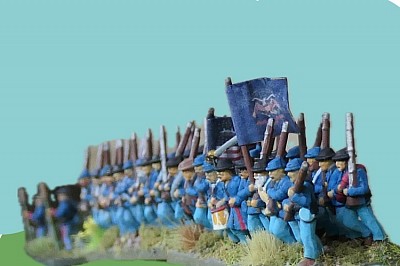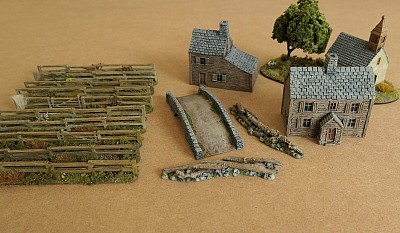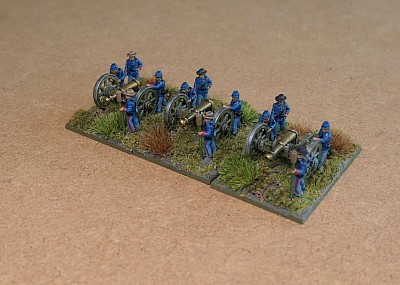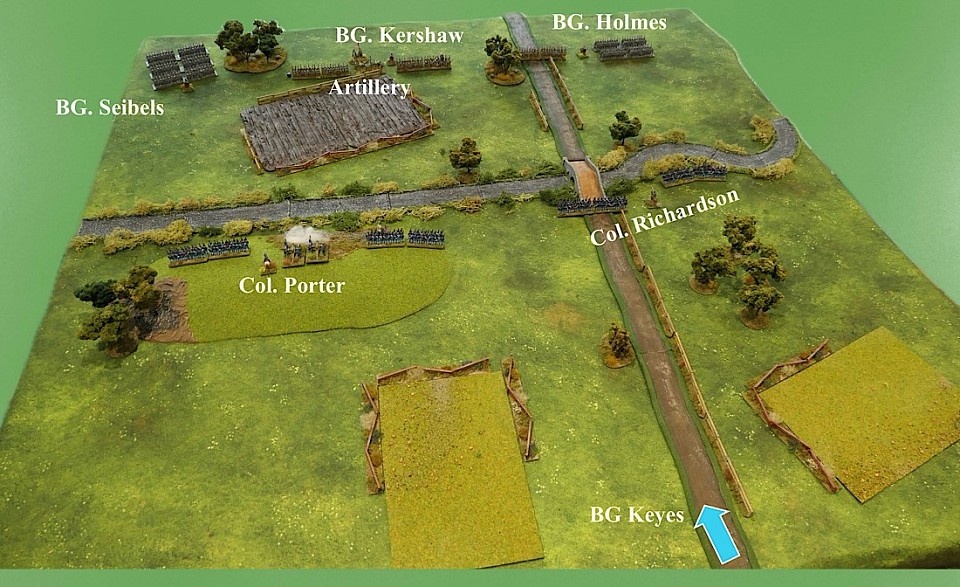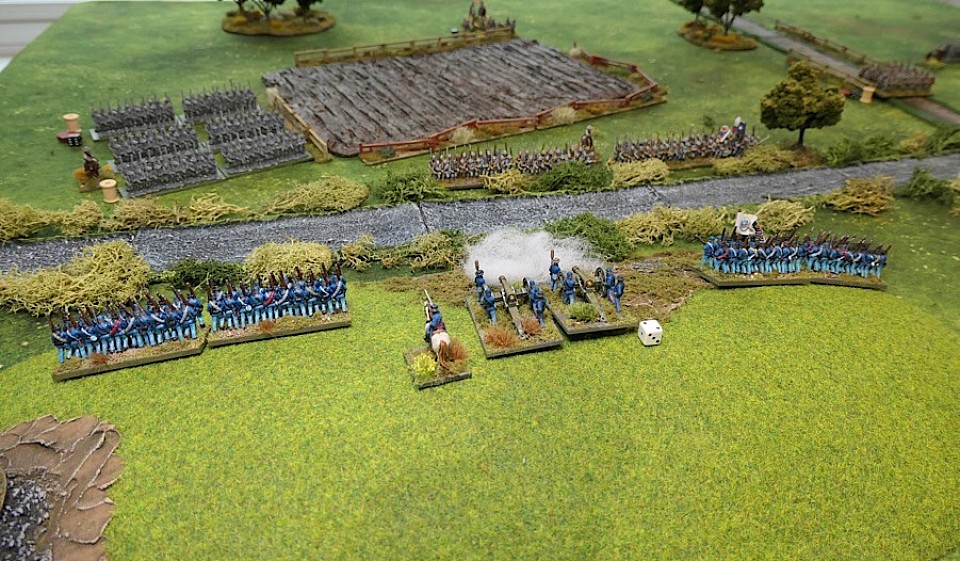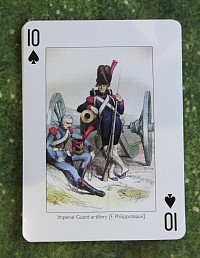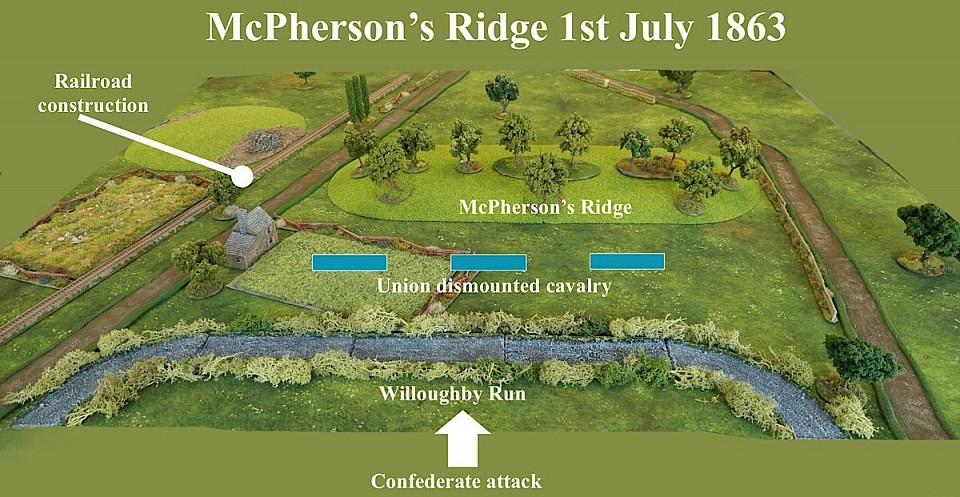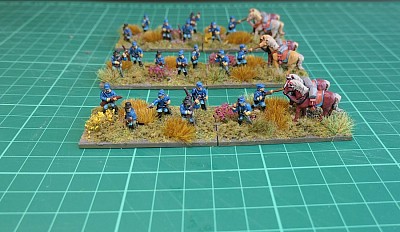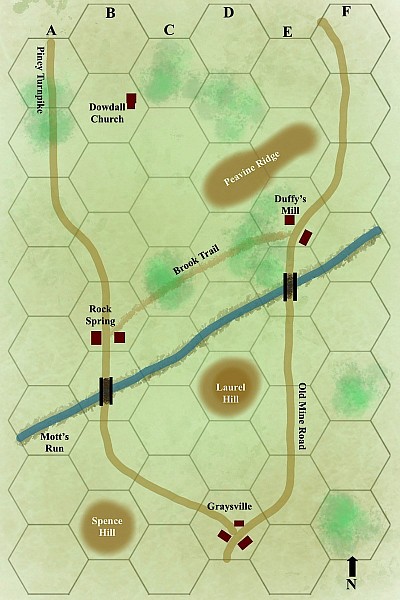ACW Epic - mini project
Starting Out - Epic ACW
This is the start of a new project that is going to use Warlord Games' Epic ACW figures to build two small forces.
My own ACW rules have three scenarios. One, called 'Action at Mill Creek', is a fictitious setting, intended for the gamer to get to grips with the rules while still having relatively few figures in their collection.
The Union have 7 regiments, while the Confederates have 8, plus both sides have an artillery battery, so the force size is ideal as the basis for a pair of our Pocket Armies, making for a do-able 'from scratch' project.
The scenario
Union forces have taken control of a crossing at Mill Creek and have artillery on the high ground. Confederate forces have been ordered to counter-attack and take both the river crossing and clear the high ground.
The Union have a third brigade marching to support their position, making this a divisional sized action.
Assuming that we are creating this scenario from scratch, our shopping list is as follows;
Terrain - 1 Hill, 1 River, 1 Bridge, 4 Woods and 1 Road.
Union Force - 1 Divisional Commander, 3 Brigade Commanders, 7 Infantry Units and 1 Artillery Battery.
Confederate Force - 1 Divisional Commander, 3 Brigade Commanders, 8 Infantry Units and 1 Artillery Battery.
Notes - Mill Creek is crossable and considered ‘difficult’ terrain. Artillery may only cross via the bridge. Moving uphill is ‘difficult’ terrain and attackers suffer a penalty on their charge test if attacking uphill.
Basing and other practicalities
As a product, Epic ACW is tied in to Warlord Games' Black Powder rule system, organised as regiments of 5 bases for a standard unit, with large units at 7 bases.
A supplied base is 60mm, so five of them gives a frontage 300mm and a head count of 100 miniatures. That frontage is greater than a typical 28mm unit would need and certainly over stretches my playing area, which is the domestic table.
So …. in the first instance, a unit will comprise of just 2 bases, giving a 120mm frontage and a headcount of 40 figures. I will see how that goes and at some future point, if enough bases get painted up, I might find that going to three bases per regiment (which is what many other gamers do) may become a preferred option, but for now, two bases it is …. and my paint brush thanks me!
For artillery, I will give the Union 3 guns and the Confederates 2 guns per battery to represent 6 and 4 gun batteries respectively.
With Epic, a consequence of the provided bases being 60mm wide and figure strips being just 55mm, means that there is a 2.5mm space at the end of each base and where the bases join a gap of 5mm between the end figures is created. It doesn't sound much, but I find it does catch the eye and disrupts the flow of the line.
So I have picked up some 55mm MDF bases. This just needs each plastic figure strip to have a sliver of base trimmed down at each end to fit the reduced base size - worthwhile in my opinion as it significantly reduces that visual gap. The only fly in the ointment is that the command base strip has the end guy with his musket pointing out to the side and interfering with the next base, but it is what it is.
For rules, I will jump between Black Powder and my own rules until I decide which gives me the sort of game that I want. The new Valour & Fortitude rules from the Perry website have just been given ACW lists, so I think those rules will also enter the mix, though I have cooled a little on the ‘card play’ aspect to those rules.
Sticking with the same scenario will help benchmark those rules against each other, plus it gives the project a firm organisational template as to what actually needs building up and painting.
Terrain
The two armies will eventually see other battlefields, so I will need a small terrain set to cover various situations. Accepting that I already have some bread and butter scale related terrain, such as roads, rivers, hills and woods, then the actual additions needed for my project battlefield are relatively few.
The buildings are 10mm resins from Battlescale. I like buildings to be at one scale lower than the figures, so these to my eye, work well will the Epic armies.
One of the buildings, described as a Chapel, has been fixed to a base with a tree from Woodland Scenics added, to be my representational piece for Dunker Church (Antietam).
The small stone footbridge and log defensive strips are also resins from Battlescale. The bridge will be ideal for small creeks and the defensive positions (tree trunks cut and laying on a low stone embankment) are pretty much multi functional.
The fences are from Red Vectors (bought from Pendraken) - code 15 FNC-02. You get 10 x 5” lengths in each MDF frame. I have just base coated them with student quality artist paint, added fine flock and sand to the bases and then just added some tufts to pretty them up. They are intended for 15mm, so are too large for my 10mm WWII stuff, but a good fit for the Epic.
I have a couple of frames of MDF Snake Fence, also from Red Vectors, that need doing up, so these will be done next while I have a bit of a terrain making momentum going.
Overall, I think this little bundle will be sufficient for most of the battlefields that I want to create.
Rolling off the painting sticks
The full order of battle of 7 - 8 regiments, 1 artillery battery and 3 brigade commanders pers side have been detached from their sprues and temporarily attached to the provided bases with a latex based glue
Except for …… the artillery. These are much easier to paint on the sprue and then fix permanently to their bases, rather than the other way around.
As per the photo, the Union battery of 3 models have now been completed (as have the two Confederate guns).
The new red paint from the Army Painter Fanatic series, has work a treat on the Union artillery crew uniforms. It lives up to its ‘high pigment’ credentials, needing just a one coat application and it has also withstood an ink wash okay.
As for that basing thing!
Above - the first confederate infantry regiment of two bases has been painted and based. You can clearly see the difference here in moving from the Warlord Games 60mm bases (on the right) to 55mm MDF bases (on the left).
To my eyes, the gap between the figure blocks on the right is too eye-catching and while on the left this is now rather snug, I feel the visual continuity of the line looks the better for being on a smaller base. A slight sliver of plastic at the end of each figure strip has had to be pared back to make this fit work.
The generic nature of the plastic sprue for both sides means that there is only one style of command strip. The slight downside here is that the strip has two flag poles. Ideal for Union bases as they carried both the National and State flag into battle, but the Confederates in general would have one flagpole.
There were exceptions, such as Texan units, which had both State and National flags and I have reflected that in the above unit …… though I may carry on double flagging Confederate units, just because I think flags make for good visuals! Otherwise, at this scale, one flag pole can just be trimmed back slightly and painted up as a musket.
Speeding up the painting
The last time that I painted Epic ACW, they simply took too long as there is a lot of detail on them. This time around I initially found the same so have taken some shortcuts that are clearly increasing the through-put of painted units.
I have made up another set of painting sticks (corks in this case) so that as I come to the end of a unit, doing the faffy bit of washing, highlighting and varnishing, which add two more days for drying etc, I can now be putting the next unit onto the 2nd set of corks and getting them primed and then dry-brushed Wraith Bone. This two day overlap is saving me … well, two days!
Also when two strips are ranked up on a base, most of that detail between the two strips (i.e. the rear of the front rank and front of the rear rank) disappears, so they have not had any tidying up touch up work done, just block painting..
Very small things like the cord holding the blanket rolls and the metal rings on the muskets that secure the barrel to the wooden body have been totally ignored. I am trying to paint a bit faster, ignoring small mistakes and just painting with the three foot rule in mind. I am forcing myself not to worry too much about a few careless mistakes - they really are unnoticeable at normal viewing distances to the Mk I eyeball (digital photography on the other hand can be rather cruel).
Taken together, I reckon that I am now painting units at double the previous rate. I think the first unit (above) looks quite respectable.
Above - A game of Mill Creek at last!
Having hit just over the halfway point with painting the armies, I thought it worth putting a game to the table.
The game is played with my own rules and Warlord Games Epic figures.
Key Moments of the battle;
Heavy lines of grey come into the view of Porter’s men who are waiting on the hill. The crack of muskets starts to fill the air.
Confederate 6th Louisiana make their first foray over the bridge, but are repulsed by 7th Indiana.
The Confederates approach the creek and firefights break out along the line. The Union artillery is targeted by some very accurate Confederate cannon fire and are forced to withdraw onto the sheltered side of the hill.
6th Louisiana gather themselves together and charge across the bridge, but the attack fails with heavy casualties and the regiment withdraws becoming ‘unsteady’ and unlikely to return to the fray.
The Confederates are suffering high losses across several regiments, but the Union also have their problems and 8th Ohio, holding the Union left, on the hill, falls back ‘unsteady’. The hill is looking vulnerable.
Soon all Porter’s brigade on the hill are in full retreat, as the Confederates sweep up onto the high ground ….. but, Keyes, with the Union reinforcement (their 3rd Brigade) has arrived and those fresh troops are making an immediate counter-attack against the hill.
5th Ohio lead the assault, but suffer heavy fire to their front and the ranks are raked by enveloping artillery fire - it is too much and 5th Ohio run back through their own lines causing disorder - the game has reached turn 9 and so we assess the battlefield.
Conclusion;
The Confederates had managed to get two regiments onto the hill. If Keyes’ assault would have worked, then likely one of the regiments would have had to leave the hill, costing them that victory objective, but with the Union assault faltering, the Confederates claim the objective.
Over at the bridge, Holmes (Confederate) had really struggled in his fight to either cross the bridge or cross the creek nearby and so he came nowhere near his objective of capturing both ends of the bridge and so with only one out of the two objectives secured, the Confederates fail and the Union call victory.
It was nice to get a game in for the project, certainly gives enthusiasm to get the rest of the Confederates painted.
I will shortly re-run this game using the Valour & Fortitude rules with their new ACW lists.
Bring Valour & Fortitude rules to the table.
It has been a while since I last played V&F rules, but armed with the latest ‘Designers Cut’ version of the rules and the ACW army lists, I re-ran the Mill Creek scenario as described above.
I have played the Mill Creek scenario many times and more often than not, the Confederates will claim the high ground (their first objective) in the closing moments of the game, but they generally fail to capture both ends of the bridge (their second objective).
So today I mixed things up a bit and assaulted the hill with a single Confederate brigade, while having the other two brigades assault the bridge. In effect this pitched 5 Confederate regiments against 2 Union regiments at the bridge, so visually there was an overwhelming tide of grey and so you would want the result to reflect that …. and it did!
Even before the end of play, the Union were in a state of full retreat. Thanks to poor die rolls, only one of the three reinforcing Union regiments had entered the table, so a counter-attack at the bridge was a non-starter.
At the Hill two Union regiments were soundly routed off the high ground and the artillery forced to retreat (in my last game, all three of those unit were unsteady and compulsively retreating - so the outcome was much the same, just a different way of doing it).
Under the V&F rules, I found myself changing the description of the bridge to ‘defendable terrain’.
I played the rules with two tweaks. Firstly using my Epic scale figures, I dropped all measurements to ⅔ and that looked right and seemed to work rather well.
Secondly, I don’t like card play that builds up into a ‘hand to be played’ with the inevitable ‘Gotcha’ type moments that fall out of that. I do however like the Random Event nature of the cards so I kept them in the game, but instead of allowing a hand to build up, in the Fate Phase of each player turn, the next card is simply turned and played by the player that turn - or lost! It seemed to work fine.
I quite like the Double Move Action as that does bring the sides into closer contact much faster and allows the game to get going properly. I also like the support rules that allow nearby units to contribute to a units fighting strength, both for firing and melee. It feels a sensible half way house from allowing units to simply gang up.
There are some elements that sit comfortably with my own rules, for example, fire occurs early in the turn and those that fire, cannot then subsequently take an Action in the Action Phase. Also the rate at which units deplete in the field is comparable to the rate of loss in my rules, with the final collapse similarly occurring, though V&F does allow for a possibility of rallying off loss, which my own rules don’t.
I found the Rally rules to be quite tame and more often than not will mainly be allowing units to recover enough strength back that they stop being shaken. It feels natural to do this when units consolidate a position that they have just taken, as they catch their breath and I suppose in part, it reflects re-organising the ranks and getting some cohesion back.
I do like that the system makes the action across the table feel like it is being conducted by separate brigades, so that even on a small table there is a sense of several different points of crisis emerging for one side or the other.
Overall, I find myself favouring the V&F rules and I just need to fully regain my familiarity with them, which has reduced this past year as I have been putting attention into my own rules. They feel like they are telling the story a bit more cohesively than my rules do.
Certainly, by now, the V&F rules have been heavily tweaked from their starting point and due I suppose to them being free rules, there has been a lot of play and feedback and the latest edition is all the better for that.
More of this I think!
The Mill Creek Project is complete!
At last we are there! I can now play the Mill Creek scenario with fully painted armies and it feels good to have reached this goal.
When I checked my notes, I began painting these in the middle of July and we are now approaching mid December, so we could call that five months. Part of me feels disappointed that I put so much effort into these, yet it has taken five months just to get this far, but then as I look at the two boxes, I feel that they are respectable forces, so perhaps I should not be too hard on myself and the result is something like 42 bases.
A few extras
You will note in the left box (Union), there is a movement tray with 5 bases of troops. These are above my initial need for the project - so you can visually ignore them. I saw them on e-bay, they looked very good and I jumped, thinking that it would be a good leg-up to the second stage of this project ... to grow the armies a little.
In some way, these tell the story of my own production problems - they look different. That is partly because they are in a darker blue (correctly so, but I like a brighter figure), but also because they are not carry as much of the painted detail as my own figures.
Now to make everything look a little more similar, I will need to spend a bit of time on them with a brush ..... but, they are a clear visual clue to me, that these figures do look nice, certainly adequate, for half the work that I have done on my own stuff and that perhaps the message here is that on my other future Epic projects, I should really be cutting down on the amount of detail that I actually paint. The truth is, at typical 3 foot gaming distances, much of that detail disappears.
However, the loss of painted detail will likely be noticed though through the unforgiving lens of digital photography and I do quite a bit of that for blogging and posting.
That in turn forms the conversation of whether I am painting for myself or for the perceived benefit of others! I have so much project work ahead of me that if that is the balance point of the argument, then I need to jump off the fence in favour of productivity over choosing a quality level that withstands the cold scrutiny of the camera.
Project sharing with friends or a club negates much of this angst. Another alternative is to play with the raw plastic. So I suppose we are all in different places in that regard and it is for each of us to find our own solution for such things.
The 'Action at Mill Creek' project is complete and I have two 'Pocket Armies', but at a more leisurely pace, I will continue to add units, perhaps taking both side up to around 12 infantry regiments and a pair of gun batteries with some cavalry (mounted and dismounted) support. As that happens, this project page will be expanded, so please pop back from time to time.
ACW Epic Project part II
With the order of battle for the ‘Action at Mill Creek’ scenario now fully painted. The next part of the ACW Epic project will be to expand the orders of battle to meet the demands of the McPherson’s Ridge scenario - also taken from my own rules.
So as before, I will base up the ‘new recruits’ on temporary bases, so that the scenario can be played while the painting is still going on.
The first bit of good news is that the present Confederate OOB will work as it is for this scenario - so no additional building there. I need to update the scenario to have Heth present for the divisional command aspect of the rules.
The second bit of good news is that I bought five painted Union infantry stands from e-bay, so I will have a bit of a leg up on getting this started.
In total, The Union will require another artillery battery, three additional infantry regiments and three cavalry regiments.
The artillery is straight forward, it just needs a couple of gun bases painting to represent the battery. I will paint these on the sprue and then assemble the guns / crew on the supplied base.
The cavalry is a bit more involved as I will need to have each regiment represented by both mounted and dismounted bases, including some horse-holder stands. Each regiment will need two bases. I am not treating the regiments as small units because they effectively act as skirmishers and they use the cavalry carbine with its high rate of fire. I also have the Union commander pack, which includes a figure of General Custer (a cavalry commander), so I can use him to make a bespoke base for Buford, the cavalry commander in the scenario.
The infantry can be done last because I already have 5 bases of e-bay pre-paints, which can be used as they are for now, with just one more base painted up and added. However, the pre-paints don’t match my own painting style, their uniform is darker (correct, but darker than I like), plus they have not had finer detail like their hair or cross belts painted - so I will feel compelled to work on them a bit if they are to match what I already have.
Also they have been mounted on 60mm MDF bases and I use 55mm across the army, not a big thing, but I will try to get a strip off one of the bases and see how that goes …. I’m not looking forward to that and if it is too destructive, then just keeping them at 60mm will be acceptable.
Terrain wise, the Part II project will need a ridge with trees on the forward slope and separate piece of high ground, two roads, an ‘under construction’ rail line, a stream (Willoughby Run), a farm house and some crop fields with fences. I already have all of these, though the rail track (N Gauge) is fully constructed, but will easily proxy. So that is another short cut to getting Part II to the table.
There isn’t really a timetable for this, as the over the next 3 - 4 months, I will be directing my painting time to getting another project off the ground. But if I make the temporary bases up now, it will frame what needs to be painted next in the ongoing ACW project.
Dismounted Union cavalry
The Gettysburg set comes with three sprues, which is meant to give a single regiment, but the way I have decided to base these means that I will get three regiments from the same sprues, each composed of just two bases.
One base has a horse holder element with a couple of horses and a couple of cavalrymen. The other base has five cavalrymen on foot, spread out in skirmisher order.
Each base is 55mm x 30mm in MDF, which will also be the size used when basing up the mounted troops.
The deeper base allows for some extra tufts just to emphasise the sense of a skirmishing unit operating in rough ground. Their first deployment will be in the McPhersons Ridge scenario, where they ambushed from amongst tall grasses, so they will be a good fit for that.
A helpful deviation
To start the year off, I fancied doing a homebrew campaign, which would give me a 'big picture' story, but be playable in plenty of relatively small table and short battles - to help a sore back as much as anything else.
There is a Graysville Campaign tab in the menu which will go into full campaign detail, but suffice to say, the extra units that I needed to paint to get that campaign under way has in consequence also significantly moved this Phase II of the ACW Project forward and soon, I hoope to be able to the McPherson's Ridge scenario to the table with a fully painted order of battle.
The new additions boost the collection with three Union mounted cavalry regiments, one Confederate mounted regiment with the dismouted base also done and two guns to make a Union battery.
I would like to spruce up those pre-painted Union infantry that I picked up on e-bay, so that they are a better match for the rest of the army.


